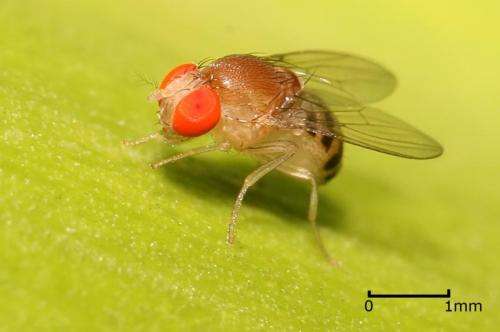For stable flight, fruit flies sense every wing beat

In order to stabilize their flight, fruit flies sense the orientation of their bodies every time they beat their wings – one beat about every 4 milliseconds.
Using computational analyses of free flight, Cornell physicists led by Z. Jane Wang, professor of physics and mechanical and aerospace engineering, made these predictions in a study co-authored by Song Chang, Ph.D. '13. The study was published online in Proceedings of the National Academy of Sciences July 21.
"We started by asking at what time scales a model fruit fly needs to sense and act in order to maintain its balance in air," Wang said. "This led to our conjecture about a fruit fly's sensing rate, and also a prediction about the function of one of its muscles."
Fruit flies have 17 pairs of steering muscles connected to their wings, all of which play a role in the flight mechanism. The exact role of each muscle during free flight is difficult to pinpoint; tiny changes during complex wing movement are also hard to observe, Wang said.
But by using computational simulations and analysis, the researchers are attacking the problem in a different way. They're investigating how fast and how frequently an insect must act to create lift and stability, starting not with the study of individual neurons and muscles, but from a framework of macroscopic physical laws.
Putting the computational results together with previous findings from recordings of motor neurons, the researchers proposed a specific neural circuitry responsible for the control of flight stability.
The study adds to Wang's overall goal of understanding the evolution of flight, and the role that such physical laws as hydrodynamics have played in the behavior of living organisms.
The framework for this simulation and control algorithm are applicable to studies of other fliers, both natural and man-made, Wang added.
The paper is titled "Predicting Fruit Fly's Sensing Rate With Insect Flight Simulations." The research was supported by the National Science Foundation.
More information: Song Chang and Z. Jane Wang. "Predicting fruit fly's sensing rate with insect flight simulations." PNAS 2014 ; published ahead of print July 21, 2014, DOI: 10.1073/pnas.1314738111
Journal information: Proceedings of the National Academy of Sciences
Provided by Cornell University



















